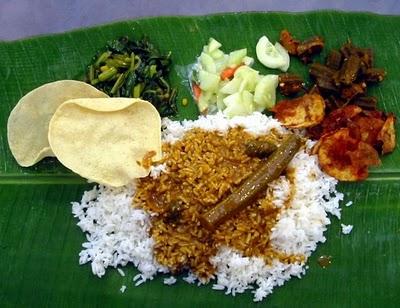Harikesa, November 21, 1975, Bombay: What do they use for utensils in a self-sufficient society?
Prabhupada: Banana leaf.
Harikesa: Cooking utensils.
Brahmananda: Clay cups.
Prabhupada: Cooking, of course, you can get pots, brass pots.
Full Conversation
“The Hidden Costs of Take-Out Meals”
National Geographic’s Green Guide: Two large, grease-stained paper bags; one small, foil-lined bag; two paper wrappers; four plastic sauce cups, with lids; three cups, one plastic, two wax-lined paper; a handful of crumpled paper napkins; and a receipt. That’s what I was left with after cheeseburgers for two yesterday.
I’m sure you’ve had this experience too, of surveying the carnage after a take-out restaurant meal. Eating out is quick, delicious, and expensive–both in money (I paid $17) and in our impact on the world around us. All that paper and plastic came from the Earth, after all, and it’s probably going to sit in landfills for decades before returning to the soil.
What to do? Well, you could stay home: Cathy Erway, author of the 2010 book “The Art of Eating In: How I Learned to Stop Spending and Love the Stove,” tried shunning restaurants. I spoke with her at the Austin festival South by Southwest about her experience and how buying restaurant food affects our planet.
As a self-regulated experiment, Erway completely avoided all carry-outs and restaurants for two years.
Seems rough, right? She suggests that once you factor in all the travel and waiting, it’s not necessarily easier or faster to eat at a restaurant. “Going out to dine should be a luxury. Some people have it the other way around, where cooking something at home is this big production,” says Erway. (For an easy at-home example, Erway suggests her Fresh Veggie Korean Pancakes.)
According to Erway, 77% of all meals “eaten out” aren’t served on tables in restaurants; a surprising amount of our food comes from carry-out food vendors, like sandwich shops (or coffee houses). And a lot of it comes with Styrofoam, which takes years to degrade.
Or break-apart disposable chopsticks: It’s a rare pair that’s made from bamboo, believe it or not. Erway says that most are cut from the heart of old-growth trees, such as aspen, and that forests are clear-cut just to make them. (A 2006 Nat Geo News article and a 2001 Washington Post article explain more about the environmental impact of disposable chopsticks.)
One question Erway gets a lot is how to date when dinner-and-a-date is verboten. “Why did we get to a place where ‘a date’ means going to a restaurant together?” she asks. She suggests dinner-over as a litmus test, under the theory that if your prospect doesn’t like it, you wouldn’t like him or her. And there’s always bowling.
Eating in also has its economic benefits. Erway says that, restaurant-free, she spent $25 a week on food in New York City. An “Opposite Week” experiment of getting all food from restaurants or carryouts cost her $200.
“The Art of Eating In: How I Learned to Stop Spending and Love the Stove” is available in bookstores.
–Chris Combs








Speak Your Mind